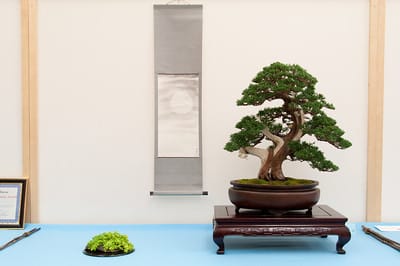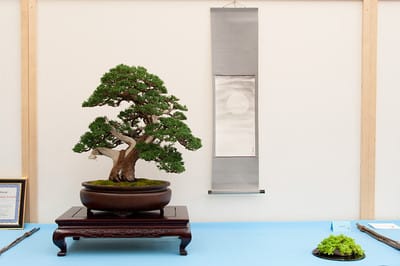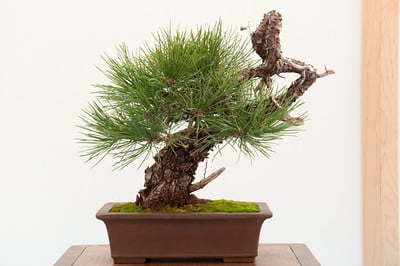Bay Island Bonsai held their 13th Annual Exhibit this past weekend at the Lakeside Garden Center in Oakland, CA. The exhibit featured a well developed shimpaku juniper.

Shimpaku juniper
Before reading any further, which way do you think the tree points – to the left or to the right?
When setting up exhibits, we often start by identifying trees that point left or right and put these at the ends of each row where they can point toward the center. Cascade and semi-cascade bonsai often end up at the ends of rows as they are strongly directional trees. With the exception of formal upright bonsai, most trees tend to point or lean a bit to the left or the right. When trees point to the left, we tend to place accent or companion plants to the right in the attempt to create balanced compositions.
The apex of the shimpaku pictured above points strongly to the left, as does the first branch on that side of the tree. My inclination was to display the tree on the right and place an accent plant on the left. Daisaku Nomoto, a bonsai professional visiting from Miyazaki, Japan, however, wanted the tree placed on the left. I winced at the suggestion, and appealed to Boon. Boon seconded Nomoto’s opinion. While we stood there discussing the matter, the tree’s owner set the tree on the right. This made sense to me and I liked the resulting display.

Displayed on the right with accent and scroll
At the end of the day, I found myself very curious about the direction of the tree. Maybe if the trunk or branches were arranged differently I could see what Boon and Nomoto saw. The next morning I asked Boon and Nomoto for an explanation. Simply put, they typically find the movement in the lower part of the trunk to be the most important element in the determination of direction. What about the apex or the key branch? Not important, Nomoto replied. It really is all about the lower part of the trunk. Tilting the tree a bit to the right would increase the movement of the lower part of the trunk and move the apex to the right. Growing out the lowest branch on the right could further this movement.
What does the tree look like displayed on the left?

As displayed on the left
Turns out the tree looks good on the left too.
Armed with new knowledge, I found a new way to look at bonsai. Like the Ponderosa pine below, for instance. Surely it points to the right?

Ponderosa pine
No such luck. Nomoto insisted the tree points to the left, just as the owner had displayed it.
Subscribe to Bonsai Tonight
New Posts Delivered Every Tuesday and Friday
bonsai eejit says
A great post Jonas! I agree that the first tree looks great to the left or right. These rules of display appear to be fluid depending on each individual tree, with no rule being set in stone. Isn’t bonsai fantastic, just when you think you understand something, another door opens 😀
Graham says
Hi Jonas, another great post. For me I noticed how my eye movement changed in the different display positions…..I try to view the display as a whole then see where my eyes go……when displayed on the right the movement of the foliage on the left point my eye to view the scroll (after the tree), while when displayed on the left the two main branches on the right made my eys flow to and point to the accent.
Cheers Graham
JT says
I heard the same explanation and I agree with you that this is very confusing. I’m still not sure which parts of the tree call the direction for display. Especially if the pine doesn’t follow the new rule. The juniper is planted slightly to the left of center so maybe that controls the movement to the right – but so does the pine. Sometimes the learning comes more slowly for me.
JT
Marty says
My initial response was that the shimpaku points to the the right. However, in the formal display I like it on the right so that the branch and apex point back to the accessory planting. In a less formal display of just the bonsai I would be inclined to place it on the left hand side so that it points to the right. I beleive it is balanced enough so that the context determines the final answer.
Michael Pollock says
After over a decade of serious bonsai study, this issue remains one that confuses me on a regular basis. I wish you had had a couple of more bonsai professionals there and asked each one separately. I bet you would have gotten more varied opinions.
The Ponderosa shows that it is a blend of a number of factors and the exact percentages in the blend are a matter of opinion.